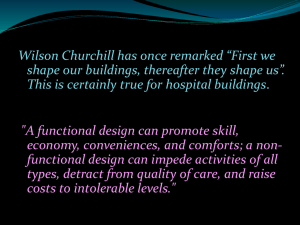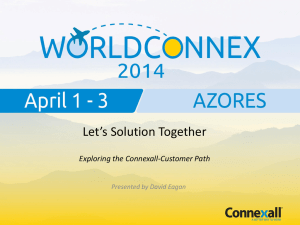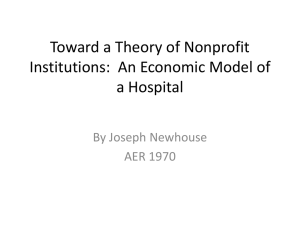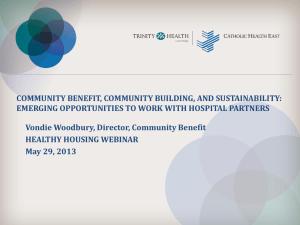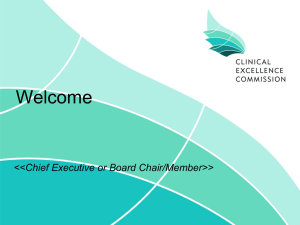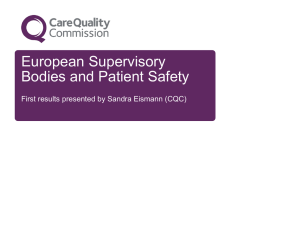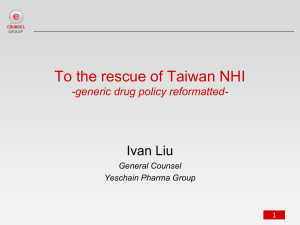Community Catalyst Curtis Presentation
advertisement
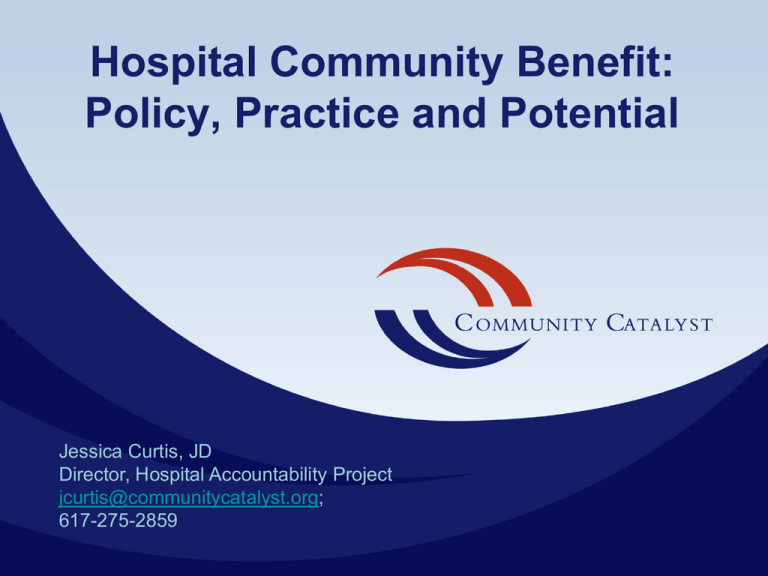
Hospital Community Benefit: Policy, Practice and Potential Jessica Curtis, JD Director, Hospital Accountability Project jcurtis@communitycatalyst.org; 617-275-2859 © 2011 BACKGROUND 1. Key community benefit policy concepts 2. Current practice and considerations 3. How communities are engaging and partnering with hospitals—or aim to! © 2014 National Breakdown: Non-Profit Hospitals National Numbers* 2,903 non-profit 1,045 state or local gov’t 1.025 for-profit *Community hospitals (open to general public) Source: Hospitals by Ownership Type, State Health Facts, Kaiser Family Foundation (2011). National Breakdown: For-Profit Hospitals National Numbers* 58.4% nonprofit 21% state or local gov’t 20.6% for-profit *Community hospitals (open to general public) Source: Hospitals by Ownership Type, State Health Facts, Kaiser Family Foundation (2011). Legal Structure Can Be Multi-Layered Federal (Constitution, Affordable Care Act, IRS) State (Tax codes, licensure, health planning statutes, AG rules) Local (Municipal ordinance, boards of health, etc.) Other (PILOT, binding legal agreements) © 2014 Community Benefit: Federal Developments • “Community benefit” is required for hospitals with federal tax-exempt status but vaguely defined • In exchange for not paying federal taxes, non-profit hospitals are expected to provide benefits to promote the health of the community (1969 Revenue Ruling) • Additional nuances appear in federal tax reporting forms • IRS and Treasury Department • Define terms • Set reporting rules (Form 990) • Investigate, monitor and enforce • Affordable Care Act (ACA) • Responded to abuses • Set new requirements Hospital Tax Exemption = $12.6 Billion Annually (2002) Source: Nonprofit Hospitals and the Provision of Community Benefit, Congressional Budget Office, 2006 Community Benefit: Federal Definition Generally, community benefit includes programs or activities that: • Improve access to health care and/or community health, advance medical or health knowledge, or relieve or reduce government or community burden; AND • Respond to an identified community need, placing particular focus on the voices and issues facing the underserved in a given place. NOT community benefit if 1) really a marketing ploy, or 2) if the hospital benefits more than the community. Examples: • Designed to increase third-party referrals • Required for hospital licensure or accreditation • Restricted to hospital employees Sources: 2013 IRS Form 990, Schedule H Instructions, pages 16-17; “Defining Community Benefit,” Catholic Health Association; Community Benefit Model Act and Commentary, Community Catalyst. Community Benefit: Federal Reporting Federal reporting requirements do specify what “counts” as community benefit, and what doesn’t, in the Form 990, Schedule H non-profit hospitals must file every year. Source: 2013 Schedule H and Instructions, Internal Revenue Service. Community Benefit: Federal Reporting Community Benefit Improves access for low-income people, helps avoid medical debt from out-of-pocket costs Improves access for low-income people; hospitals may take financial hit NOT Community Benefit (Still Reported in Schedule H) Financial Assistance Bad Debt Medicaid Shortfall (plus Medicare Shortfall other public programs for low-income people) Community health Community building improvement services Patients end up in collections, plus all businesses write off some bad debt All over 65 qualify regardless of need; Medicare rates set so hospitals can profit Health professions education Subsidized health services Research Cash and in-kind contributions to other groups Both count “upstream” activities that address the social determinants of health, like economic development, environmental health, workforce development, housing—even coalition building, leadership development, health advocacy. There is a higher threshold for a program to count as community benefit. Source: 2013 Schedule H and Instructions, Internal Revenue Service. Community Building: Movin’ on Upstream…Slowly Community Building Physical Improvements and Housing Economic Development Community Support Environmental improvements Leadership development and training for community members Coalition building Community health improvement advocacy Workforce development Examples Rehabbing or providing housing for vulnerable populations, neighborhood improvement projects, developing parks or playgrounds to increase physical activity Assisting small business development for vulnerable populations; creating new jobs in areas with high joblessness rates Child care and mentoring programs for vulnerable populations; violence prevention; disaster preparedness (beyond what’s required by law) Alleviating air or water pollution; waste removal and treatment Conflict resolution training; medical interpreter skills for community residents; civic, cultural or language skills Participating in community coalitions and other collaborations to address health and safety Supporting policies and programs (access, housing, environment, transportation) Recruiting to shortage areas; training and recruiting health professionals needed in community Under the Affordable Care Act, all nonprofit hospitals must have: 1. Written, well-publicized financial assistance policy 2. Fair charges for patient care 3. Fair debt collection practices 4. Regularly assess the health needs of their communities, with input from community and public health leaders, and develop implementation plans to address needs The Affordable Care Act changes the requirements for federal tax-exempt status for hospitals. Community Benefit: Proposed Federal Rules • Allow collaboration • Require input from public health and community members and representatives • Provide an additional tool for advocates to use to weigh in on health equity, access, and public health issues impacting the community • Require board approval on community benefit, financial assistance, billing and collection policies © 2012 So, Where Are We Today? In 2009, U.S. hospitals spent: • 7.5% overall expenses on community benefit • Over 85% focused on access to care Chart Credit: Martha Somerville, Somerville Consulting. Source Credit: Based on Young, G., et al. (2013) Provision of community benefit by tax-exempt U.S. Hospitals. N. Engl J Med. 368: 16 © 2014 Across U.S., Most Community Benefit Dollars Still Spent on Access to Care Based on: UWPHI County Health Rankings & Roadmaps Young, G., et al. (2013) Ranking Methods: Health Factor Weights for Provision of community benefit by taxthe 2013 Health Rankings exempt U.S. Hospitals. N. Engl J Med. 368: 16 Credit: Martha Somerville, Somerville Consulting. © 2014 State Example: Oregon Hospitals’ 2012 Community Benefit Spending (Total: $1.78 Billion) Charity Care Medicaid Shortfall Medicare shortfall Community Health Improvement Research Health Professions Education Subsidized Health Services Cash and In-Kind Contributions Community Building © Community Catalyst 2014 Source: 2012 Community Benefit Reporting Report, Oregon Health Authority Office of Health Analytics Community Benefit: Canary in the Coal Mine or Lever for Change? “Adopting a population-based approach to care that encompasses the spectrum of determinants of health is essential for care systems to thrive in the ACA era. To improve health outside their walls, hospitals and care systems must engage in multisectoral partnerships….” - American Hospital Association and Association for Community Health Improvement Source: “Trends in Hospital-Based Population Health Infrastructure: Results from an ACHI and AHA Survey,” Association for Community Health Improvement (December 2013) © 2014 Community Benefit: Canary in the Coal Mine or Lever for Change? © 2014 Looking Ahead: Potential to Partner • Three-site pilot program – The Bronx, New York City – Phillips Neighborhood, Minneapolis – Metro Portland, OR • Staff support and technical assistance – Policy analysis – Analyzing hospital community benefit data/process – Preparing for hospital meetings • Test training curriculum (June 2014 release) – – – – Personal systemic Broad view of health (economic, environmental) Community benefit, hospital dynamics Basic organizing skills (CBPR, negotiations) © 2014 Fundamental Premise “Regardless of the scale on which a community assessment is conducted, it is likely to be most effective if it…respects both stories and studies, and places its heaviest emphasis on eliciting high-level community participation throughout the assessment [implementation and evaluation] process.” Hancock and Minkler, “Whose Community? Whose Health? Whose Assessment?” © 2014 $$$$ Influence Expertise & Resources Data Initial Observations • Data gaps (especially for racial and ethnic minorities, limited English proficiency speakers, and other vulnerable populations) • Defining the community – some surprises • Training participants/organizations generally not at the table for hospital planning/assessment phases, or during prioritization • Community health needs assessment (CHNA) tend to use broad definition of health, but implementation strategies were narrowly tailored to “legacy” programs and/or issues more closely related to health care • Community appetite for financial information and interest in pursuing next steps with hospitals © 2014 Questions • Is all the data we need or want publicly available? Are there any findings that surprise us? Things we want hospitals to improve? Shared interests? • Whose voices and perspectives did the hospital seek? Whose are missing? • How were community needs prioritized? Who decided and with what criteria? • Are there missing pieces or relationships that we can bring to bear? • How is the hospital moving forward? How can © 2014

